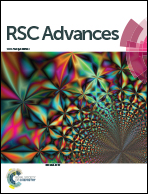Cobalt(iii) acetylacetonate initiated RAFT polymerization of acrylonitrile and its application in removal of methyl orange after electrospinning†
Abstract
This study describes reversible addition–fragmentation chain-transfer (RAFT) polymerization initiated by cobalt(III) acetylacetonate (Co(acac)3). With Co(acac)3 as the initiator, RAFT polymerization of acrylonitrile was achieved at 90 °C mediated by 2-cyanoprop-2-yl dithionaphthalenoate. The polymerization exhibited “living”/controlled characteristics with a molar mass distribution as low as 1.25. Homogeneous polyacrylonitrile nanofibers (PAN-nFs) were produced via the electrospinning technique. FTIR, SEM and TGA analyses revealed aminated-PAN-nFs (APAN-nFs) were successfully obtained via ethylenediamine grafting onto the surface of PAN-nFs. The adsorption interaction between methyl orange (MO) dye and APAN-nFs is discussed in detail. The maximum saturation adsorption capacity was 102 mg g−1. The adsorption kinetics followed a pseudo-second-order model. The Langmuir model was better for interpreting the isothermal process for MO and APAN-nFs. The Dubinin–Radushkevich isothermal model indicated that the adsorption proceeded chemically. Intraparticle diffusion was not the only rate-limiting step. The thermodynamics properties indicated the adsorption process was exothermic and spontaneous in nature. The MO dye adsorbed by APAN-nFs could be reversibly desorbed by an aqueous solution of pH = 1. APAN-nFs could be recycled efficiently.


 Please wait while we load your content...
Please wait while we load your content...